
à la carte: To start, please tell me how you learned how to cook.
M. Médigue: I think it started with my grandmother. When I was a child I was wondering all the time what she was cooking. So I had an early interest in food. When we had a family gathering, my cousins would always leave the table before the end of the meal, but I would wait because I wanted to see what the main course was. I was all the time curious about food, and when you are curious about something you want to know more.
à la carte: How did you start professionally?
M. Médigue: I was not very good at school. My father didn’t want me to become a chef because at this time — over thirty years ago — chefs were somebody with a big red nose, drunk in the back of the kitchen — that was the image before [Paul] Bocuse elevated the image of a chef to where it is today. My father didn’t want me to become a chef, so maybe that’s why I said I wanted to do it! My grandparents wanted me to be a chef. They had operated a restaurant in the south of France when they were younger, and they had a friend who was a chef at the [Hotel] Négresco, and he said that he would accept me as an apprentice.
à la carte: How old were you then?
M. Médigue: I was 15 years old — a long time ago. Because I was under 16, I had to obtain permission from the president of France to quit school early.
à la carte: In those days, the restaurant in the Négresco was very prominent.
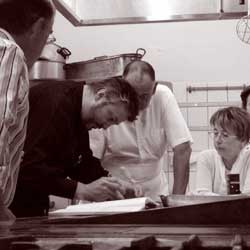 M. Médigue: Yes, it was still the old-style Négresco with thirty people in the kitchen. The chef was in his sixties. The sous-chef was just a few years younger. And most of the chefs de partie were in their fifties. The youngest one — his name was Rodriguez — was thirty-four. Below them were the commis and the [three] apprentices — a first-year apprentice, a second-year apprentice, and a third-year apprentice. The first day I arrived there they gave me a full box of carrots to peel. I took the carrots and a peeler and after ten minutes I had one carrot peeled! I said to myself that it was going to take a long time to do the whole box. But that’s how you start.
M. Médigue: Yes, it was still the old-style Négresco with thirty people in the kitchen. The chef was in his sixties. The sous-chef was just a few years younger. And most of the chefs de partie were in their fifties. The youngest one — his name was Rodriguez — was thirty-four. Below them were the commis and the [three] apprentices — a first-year apprentice, a second-year apprentice, and a third-year apprentice. The first day I arrived there they gave me a full box of carrots to peel. I took the carrots and a peeler and after ten minutes I had one carrot peeled! I said to myself that it was going to take a long time to do the whole box. But that’s how you start.
à la carte: But, obviously you learned along the way. So were you at the Négresco for three years?
M. Médigue: No, I was very lucky. At this time the government wanted apprenticeships to be shorter so I was an apprentice for just two years. (A couple of years later, the apprenticeship was switched to three years long again.)
à la carte: So at seventeen, you were off to another place to work?
M. Médigue: Yes, I went to the Château de Divonne les Bains, a [Michelin] one-star restaurant close to Geneva. I was there for the summer season, five months, as a commis de cuisine. The chef was from the Négresco — he worked here in the summer. After that, I worked the winter season at an auberge called Soleige 1850 la Foux d’Allos. Again as a commis. Then the pastry chef quit just before Christmas. The chef asked me if I knew how to make pastry, and I said “oh, yeah.” Every lunch we had 400 guests. The first time I said I’m going to make a nice apple tart. I didn’t realize that to make apple tarts for 400 people is a hell of a job! But I did it, and gradually I learned how to produce food in quantity by myself.
à la carte: And you were now about 18?
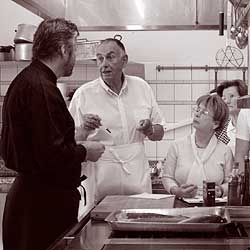 M. Médigue: Yes. So the next summer I went again to the Château de Divonne. After the end of the season, the owner of the château, M. Anthonioz, who was the Minister of Tourism, asked me to replace his cook, who had become sick, at his private residence for a couple of months. So I worked for him for two months. I did everything. I bought the food, cooked it, served it, and even washed all the pots. It was great. I really enjoyed that. After that, when you are 18 in France you have to go into the army. So before I was called up, which would have meant I was sent to some cold place in Germany, I decided to enlist for the minimum, 18 months, and go to New Caledonia. Better weather. That was my first trip outside of France. While I was in New Caledonia, I wanted to go to Australia. I went to the Australian consulate office and they told me, “But you don’t speak English.” I said, “No.” And they asked, “Why do you want to go to Australia is you can’t speak English?” So I started studying English at evening classes. After I learned English I decided that I didn’t want to go to Australia anymore, so I went back to Europe. Finally, I wound up in London and worked two years at the Portman Hotel [part of the Inter-Continental Hotel chain]. I was 20 years old. I started as a demi-chef de partie. A year and a half later I was sous-chef. Along the way I had become chef saucier. There had been a very good chef saucier there when I came, but he had quit. They tried a couple of replacements, but they all quit, too. So they asked me. So I was [first a] chef saucier and then became a sous-chef as a chef saucier. That was heavy. It was a lot of work. The restaurant had about 130 seats and on weekends, the restaurant was very full. My area of responsibility was the grill, and about of one-third of the menu was grilled items — steaks and fish. Plus every day I had to prepare a full roast prime rib served from a wagon with Yorkshire pudding. And every day there was the mise en place followed by the carving, the grill, the preparation of sauces — I was quite busy.
M. Médigue: Yes. So the next summer I went again to the Château de Divonne. After the end of the season, the owner of the château, M. Anthonioz, who was the Minister of Tourism, asked me to replace his cook, who had become sick, at his private residence for a couple of months. So I worked for him for two months. I did everything. I bought the food, cooked it, served it, and even washed all the pots. It was great. I really enjoyed that. After that, when you are 18 in France you have to go into the army. So before I was called up, which would have meant I was sent to some cold place in Germany, I decided to enlist for the minimum, 18 months, and go to New Caledonia. Better weather. That was my first trip outside of France. While I was in New Caledonia, I wanted to go to Australia. I went to the Australian consulate office and they told me, “But you don’t speak English.” I said, “No.” And they asked, “Why do you want to go to Australia is you can’t speak English?” So I started studying English at evening classes. After I learned English I decided that I didn’t want to go to Australia anymore, so I went back to Europe. Finally, I wound up in London and worked two years at the Portman Hotel [part of the Inter-Continental Hotel chain]. I was 20 years old. I started as a demi-chef de partie. A year and a half later I was sous-chef. Along the way I had become chef saucier. There had been a very good chef saucier there when I came, but he had quit. They tried a couple of replacements, but they all quit, too. So they asked me. So I was [first a] chef saucier and then became a sous-chef as a chef saucier. That was heavy. It was a lot of work. The restaurant had about 130 seats and on weekends, the restaurant was very full. My area of responsibility was the grill, and about of one-third of the menu was grilled items — steaks and fish. Plus every day I had to prepare a full roast prime rib served from a wagon with Yorkshire pudding. And every day there was the mise en place followed by the carving, the grill, the preparation of sauces — I was quite busy.
à la carte: Did you have a commis to help you?
M. Médigue: Oh yes. I had one commis. We had the day shift. There was another person for the evening shift.
à la carte: So after England you come back to France?
M. Médigue: No. I wanted to travel so they sent me to Sri Lanka. I had a contract for two years in Sri Lanka with the Inter-Continental Hotel, but after one year I said I was done. A food and beverage manager, who happened to be French, came from Hong Kong for a vacation, and we became friends. He told he that he would find a job for me in Hong Kong. Six months later, I had four interviews in Hong Kong — the Mandarin, the Inter-Continental, the Méridien, and the Hyatt. I chose the Méridien. So I quit my job in Sri Lanka, but the Méridien wasn’t finished yet! I had to wait six months. So I found a job in Paris for six months at the Hôtel de Crillon. After that I left for Hong Kong. I arrived in Hong Kong where I had a two-year contract, but after less than a year, Jean-Paul Bernard, the chief at the Crillon, who was consulting for one of the major hotels in Tokyo, stopped in Hong Kong on a trip and told me that if I wanted a job in Japan, I could have one. And that’s how I wound up in Japan for six years. When I quite my job in Hong Kong, I told the general manager what my salary in Japan would be and he said that it was more than he was making, and he wished me luck. Six years was a long time for me. Up until then, I had been at each place for a fairly short period.
à la carte: In Japan, were you actually running a restaurant?
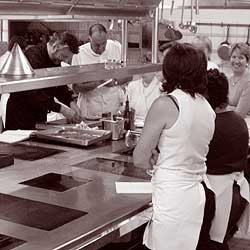 M. Médigue: When I arrived in Japan, I was the chef français. There was also a Japanese chef. I realized after a few weeks that I was the French chef, but I was chef of nothing. He was the chef of the restaurant. I was just there to greet the guests in the restaurant. The food was not the food I wanted to prepare. I said to myself that I would stay one year and then leave. I was making a very good salary for doing almost nothing. I spent nine hours a week studying Japanese with an additional nine hours of homework each week. One morning each week I taught a cooking class for the employees of the restaurant. They wanted me to provide a suggestion de jour for the menu, but they wanted me to provide this a month in advance so they could print it. I said, “How can I give you a suggestion for today a month ahead when I don’t know what will be in the market then?” The chef and I were not friends. After one year I decided to ask that my salary be increased by forty percent, [even though] I was already making a very good salary. To my surprise, they agreed. So I decided to stay for another year. But, I was getting upset everyday with the chef. He had a very strange way of working. Plus, he was getting a kickback on everything he was buying. Or he would buy 2000 lobsters and cook them all in the same water — you can imagine how bad the water was by the end. And then he would freeze them. I didn’t like this way of working. I couldn’t stand it. He was spending too much money on food that was bad and had to be thrown away. At one point, a week-long visit by [Charles] Barrier was arranged. [At the time, Barrier was one of France’s premier chefs.] When Mr. Barrier came, after one hour being around the chef, he said to me, “Please ask the manager to send this guy on vacation while I’m here.” He couldn’t stand him. So I went to see the manager. I said, “Can you send the chef on vacation during Mr. Barrier’s week?” He replied, “That’s impossible. He’s the chef.” I said, “If he doesn’t go, Mr. Barrier goes. You chose.” So they sent the chef to a special class in Tokyo for two weeks. After the two weeks I told the owner, Mr. Obayashi, that I couldn’t stay and that I would go back to France to work with Mr. Barrier. But, he wanted me to stay. Mr. Obayashi said, “How about you become the chef and the Japanese chef becomes your sous-chef?” I said, “No, no. I don’t want him even as a dishwasher. I don’t want this guy in the kitchen, at all.” So they fired him, and I stayed on as chef. I was in charge. I had to go to all the meetings. They provided me a secretary because I couldn’t write Japanese. And that’s how I stayed in Japan for four more years, as a real chef. Of course about half of the kitchen quit — the older cooks. So I built a team from the nine younger cooks.
M. Médigue: When I arrived in Japan, I was the chef français. There was also a Japanese chef. I realized after a few weeks that I was the French chef, but I was chef of nothing. He was the chef of the restaurant. I was just there to greet the guests in the restaurant. The food was not the food I wanted to prepare. I said to myself that I would stay one year and then leave. I was making a very good salary for doing almost nothing. I spent nine hours a week studying Japanese with an additional nine hours of homework each week. One morning each week I taught a cooking class for the employees of the restaurant. They wanted me to provide a suggestion de jour for the menu, but they wanted me to provide this a month in advance so they could print it. I said, “How can I give you a suggestion for today a month ahead when I don’t know what will be in the market then?” The chef and I were not friends. After one year I decided to ask that my salary be increased by forty percent, [even though] I was already making a very good salary. To my surprise, they agreed. So I decided to stay for another year. But, I was getting upset everyday with the chef. He had a very strange way of working. Plus, he was getting a kickback on everything he was buying. Or he would buy 2000 lobsters and cook them all in the same water — you can imagine how bad the water was by the end. And then he would freeze them. I didn’t like this way of working. I couldn’t stand it. He was spending too much money on food that was bad and had to be thrown away. At one point, a week-long visit by [Charles] Barrier was arranged. [At the time, Barrier was one of France’s premier chefs.] When Mr. Barrier came, after one hour being around the chef, he said to me, “Please ask the manager to send this guy on vacation while I’m here.” He couldn’t stand him. So I went to see the manager. I said, “Can you send the chef on vacation during Mr. Barrier’s week?” He replied, “That’s impossible. He’s the chef.” I said, “If he doesn’t go, Mr. Barrier goes. You chose.” So they sent the chef to a special class in Tokyo for two weeks. After the two weeks I told the owner, Mr. Obayashi, that I couldn’t stay and that I would go back to France to work with Mr. Barrier. But, he wanted me to stay. Mr. Obayashi said, “How about you become the chef and the Japanese chef becomes your sous-chef?” I said, “No, no. I don’t want him even as a dishwasher. I don’t want this guy in the kitchen, at all.” So they fired him, and I stayed on as chef. I was in charge. I had to go to all the meetings. They provided me a secretary because I couldn’t write Japanese. And that’s how I stayed in Japan for four more years, as a real chef. Of course about half of the kitchen quit — the older cooks. So I built a team from the nine younger cooks.
à la carte: So actually at this point you are already becoming a teacher?
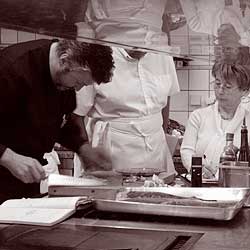 M. Médigue: Even if you have someone join your staff who is experienced, he may not prepare everything the way you want it. If you want someone to do things your way, you have to teach him. There is also this thing in Japan called sensei, or teacher. Even after I became the chef, they still called me sensei. Once a month, I went to [one of] the Japanese schools to teach in a large classroom with 120 students. There was a special table for cooking with overhead mirrors.
M. Médigue: Even if you have someone join your staff who is experienced, he may not prepare everything the way you want it. If you want someone to do things your way, you have to teach him. There is also this thing in Japan called sensei, or teacher. Even after I became the chef, they still called me sensei. Once a month, I went to [one of] the Japanese schools to teach in a large classroom with 120 students. There was a special table for cooking with overhead mirrors.
à la carte: And you taught those classes in Japanese?
M. Médigue: Yes. They had an interpreter because most of the chefs who were teaching were French. But I realized it was better for me to speak in Japanese because the interpreters usually had a literary rather than a culinary background. They didn’t know the words of cooking. They didn’t know about food.
à la carte: So that goes on for a total of six years and then you come back to France?
M. Médigue: Well before that, I married Mme. [Pascale] Médigue. She was my little sister’s friend. I came back to France almost twice a year. One Christmas, while I was home we met. She took a year’s leave from work to live with me in Japan. Then a friend of ours, during one of our vacations back to Besançon, said, “I have to show you something.” We visited the château [in Amondans]. And that night I couldn’t sleep. The first night of my life I couldn’t sleep. I figured out the menu…I figure out everything. We put the numbers together, but they were deep red. The château was for sale for not too much money, so we decided to buy the château no matter what we would do with it. Then we came back to Japan, and I had the idea, with a friend, to make a school at the château. I went to see Mr. Tsuji, a potential partner. But he said he wouldn’t be a partner with me. So I went home thinking the school wouldn't be possible. But he called me the next day and said, “I won’t be a partner with you — putting the money together — but if you create the school, I will send the students.” So I said, “How are you going to sent the students?” He replied, “With a contract. And if you want, after we sign the contract, I will send you some money in advance.” This was enough money to start to work on the château. So that’s how the school was born.
à la carte: And what year was that?
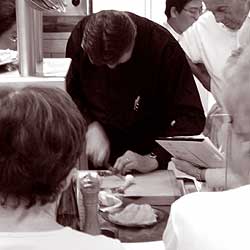 M. Médigue: I left Japan in 1989. We arrived back here on September 27, 1989 — exactly six years to the day after I arrived in Japan. Pascale was in shock. We had a very nice life in Japan. We had a car and lots of invitations. I was a big guy in the company and a sensei. And then we arrived at the château. We lived together in the small house by the gate. It was not refurbished, yet. It was very ugly. But we were starting the school.
M. Médigue: I left Japan in 1989. We arrived back here on September 27, 1989 — exactly six years to the day after I arrived in Japan. Pascale was in shock. We had a very nice life in Japan. We had a car and lots of invitations. I was a big guy in the company and a sensei. And then we arrived at the château. We lived together in the small house by the gate. It was not refurbished, yet. It was very ugly. But we were starting the school.
à la carte: When did the first group of students come?
M. Médigue: The first group arrived on the 28th of August, 1990 — not a long time to complete all the work required to turn the château into a school, especially with French workers who don’t work as fast as those in Japan. In Japan we completely remodeled the restaurant, which was on the 30th floor, in two months. The space was completely gutted and rebuilt, all 12,000 square feet. Here it was difficult to be ready in a year. But then the students arrived. Only the kitchen, classroom, and dormitory were completed. My house was still not ready. The restaurant was not ready.
à la carte: So how many students were in the first class.
M. Médigue: We had a contract of 110 students a year, so there were 55 students.
à la carte: How long did the students come for?
M. Médigue: They came for six months at a time paying about 70,000 francs. It was a lot of money.
à la carte: Fifty-five students in the classroom doesn’t seem like a problem, but 55 in the kitchen must have been crowded.
M. Médigue: No, we had five groups — two in the kitchen, one in the bakery, one doing pastry, and one group learning service. They rotated every two days.
à la carte: I assume that you were not teaching all 55 students by yourself.
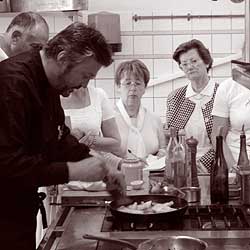 M. Médigue: No, I had two chefs in the kitchen plus one doing bread and pastries. There was also a gentleman in charge of service. We also had four assistants from Japan, one in the bakery, one in patisserie, one in the kitchen, and one in service. I think at that time, we had the best school that you could find anywhere. The level of all the teachers was excellent. We had about one teacher for each ten students. The result was excellent.
M. Médigue: No, I had two chefs in the kitchen plus one doing bread and pastries. There was also a gentleman in charge of service. We also had four assistants from Japan, one in the bakery, one in patisserie, one in the kitchen, and one in service. I think at that time, we had the best school that you could find anywhere. The level of all the teachers was excellent. We had about one teacher for each ten students. The result was excellent.
à la carte: Were you teaching daily at this time?
M. Médigue: I wore a lot of hats then, but I would teach in the classroom in the afternoon. In the morning, the students would start at eight-thirty. They would prepare food until twelve, and then eat until about twelve-thirty. At two o’clock in the afternoon, everyone would be in the classroom for a course. Every week, once a week, there would be un grand chef, minimum one-star Michelin. Sometimes we would have one, sometimes two, sometimes three. We had Pierre Gagnaire, Emil Jung, Charles Barrier, Louis Outhier. We had all the one-star chefs of the Franche-Comté and Burgundy. We had Roland Durand from Paris with two stars. The level was great. So once a week they had one grand chef, one pastry demonstration, one cooking demonstration that I was doing, a course about items like wines, and finally a course about technical items like sanitation. It worked quite nicely.
à la carte: So this started at the end of the summer of 1990 and lasted until when?
M. Médigue: We ran this way until ’95. We had a contract of nine years, but in January 1995 there was the earthquake in Kobe. They were already having a hard time sending students. The first group was full, most groups were only about thirty students, but they would send the money for fifty-five. It was starting to be tough for them because it was a lot of money. They used the earthquake as an excuse to break the contract. We had a problem because be had invested a lot of money in remodeling the château. Just redoing the wiring cost 650,000 francs. We had to borrow a lot of money from the bank. We had been able to set a little money aside, but not enough to pay off the loans. We decided to look for another school in Japan to contract with but no luck. We tried Korea. We tried Thailand. We tried China. And when this didn’t work, we decided to open a restaurant. That’s how we opened a restaurant in the château in May, 1996. [Louis] Outhier came here to help us.
à la carte: Was Outhier retired by then?
M. Médigue: Yes, but only for two or three years. There were a lot of people who were not aware that he had retired. It was very good for us. The timing was great. We had 600 names on our mailing list. Even through the winter we had at least one table every day. In 1997, Gault-Millau rated us as 13 with one toque. In 1998, we were in the Michelin guide with three forks. In ’99, we received our first star. And then, the business really started.
à la carte: You’re now teaching individuals from the community. When did this start?
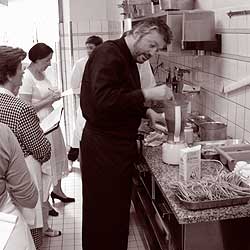 M. Médigue: The first person, Noëlle Defago, actually started to come with the last of the students. In 1996, we still had a few students who were coming — not many, maybe ten. We were still running, but we didn’t make money. We tried at this time to have local people come to learn how to cook, but they could not stand to learn in the classroom like a student. They wanted to learn, but they wanted to learn in the kitchen. One winter, Papu [the chef’s father-in-law] asked us, “Why don’t you teach the course in the kitchen and stay in the kitchen with the chef?” I said, “What will change? For me it is better for the students to sit in the classroom where everyone can see all that is going on.” But, as soon as we added to the advertisement “dans le cuisine avec la chef” — it’s only a few words — we couldn’t understand what was happening — everyone wanted to come. They didn’t want to come to learn in the classroom, but they wanted to come to learn in the kitchen with the chef. In the classroom we were advertising that Mr. Jean-Michel Lorain or Mr. Louis Outhier was going to teach, but no one would come. We would have just one or two students.
M. Médigue: The first person, Noëlle Defago, actually started to come with the last of the students. In 1996, we still had a few students who were coming — not many, maybe ten. We were still running, but we didn’t make money. We tried at this time to have local people come to learn how to cook, but they could not stand to learn in the classroom like a student. They wanted to learn, but they wanted to learn in the kitchen. One winter, Papu [the chef’s father-in-law] asked us, “Why don’t you teach the course in the kitchen and stay in the kitchen with the chef?” I said, “What will change? For me it is better for the students to sit in the classroom where everyone can see all that is going on.” But, as soon as we added to the advertisement “dans le cuisine avec la chef” — it’s only a few words — we couldn’t understand what was happening — everyone wanted to come. They didn’t want to come to learn in the classroom, but they wanted to come to learn in the kitchen with the chef. In the classroom we were advertising that Mr. Jean-Michel Lorain or Mr. Louis Outhier was going to teach, but no one would come. We would have just one or two students.
à la carte: So when the contract with Japan ends in ‘95, you started teaching people from the community?
M. Médigue: No. The half-day courses like we have today didn’t start until 1998 or ‘99.
à la carte: And now you teach three groups of students: those who still come from Japan for practical training, stagiaires from France, and people from the community?
M. Médigue: Yes. Today, we are a restaurant, but we are also a school.
à la carte: Do you prefer to teach by demonstration, especially for students from the community, or with a hands-on method?
M. Médigue: It depends on the students. For some [of the community] classes, people only want to watch. At other times, everyone wants to hold a knife and help me. Some students want to help all the time, but other students object because they are concerned about sanitation. It really depends on the group. In my opinion, you learn more when you actively participate than when you just watch.
à la carte: You’ve also talked recently about having a new cooking school when the château is closed in the winter.
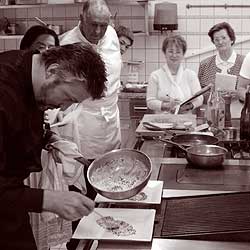 M. Médigue: I don’t like the term cooking school. It will be called L’Atelier Gourmand de Château d’Amondans. Atelier means workshop, gourmand for food, and Amondans because everyone in this area knows Amondans. On Monday and Saturday, we will have a morning course that includes a full lunch — as we currently run at the Château. On Tuesday and Thursday, we will have an afternoon course with just a tasting of the dishes prepared. On Friday night, we will open as a restaurant for only 15 guests. It will be set up more as a nice home kitchen instead as a professional kitchen. It will be like what you see on TV.
M. Médigue: I don’t like the term cooking school. It will be called L’Atelier Gourmand de Château d’Amondans. Atelier means workshop, gourmand for food, and Amondans because everyone in this area knows Amondans. On Monday and Saturday, we will have a morning course that includes a full lunch — as we currently run at the Château. On Tuesday and Thursday, we will have an afternoon course with just a tasting of the dishes prepared. On Friday night, we will open as a restaurant for only 15 guests. It will be set up more as a nice home kitchen instead as a professional kitchen. It will be like what you see on TV.
à la carte: If you had a choice at this time to spend all your time running the restaurant or all your time teaching, could you choose one activity over the other?
M. Médigue: My feeling is, I think I will be very, very happy with what we are going to do because having a restaurant all year ‘round is the best way to go mad. But completely stopping this business that I’ve been doing twelve hours a day since I was 15 years old is also out of the question. It is like a drug. I couldn’t give it up. So running the restaurant for six months, even if there are some tensions, will not be so bad. You know that at the end of the season you can take a breath. In the winter time, I will have plenty of time by myself, with students, to have new ideas, to evaluate what we are doing, and to make changes. Most chefs stay in the kitchen and serve the same food for ten or more years. Sometimes it works. But for me, I think I will be very happy to spend some of my time creating and some of my time being a chef. I think one activity will help the other.
à la carte: Do your students from the community ever report back to you how their “homework” went?
M. Médigue: Oh yeah. And I’m surprised because I think that sometimes they may not be getting it, but they do exactly as they are taught. I have some guests who come to the restaurant because they have eaten a dish prepared by one of their friends, who learned the dish here in a course. Once I had chef of a restaurant, who was a friend of a lady who learned how to make cassoulet, taste the cassoulet at her house. He said, “If the cassoulet is like that, I’ll go to the restaurant of the guy who taught you.” He came and was very happy. He would not have come if he had not tasted the cassoulet.
à la carte: It has been interesting talking with you. Thank you for spending the time with me.
M. Médigue: You’re welcome.


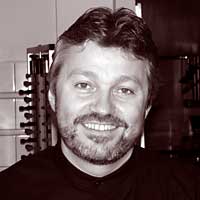
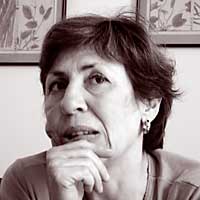
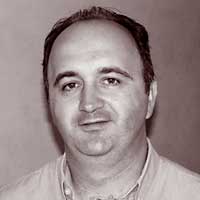



 M. Médigue: Yes, it was still the old-style Négresco with thirty people in the kitchen. The chef was in his sixties. The sous-chef was just a few years younger. And most of the chefs de partie were in their fifties. The youngest one — his name was Rodriguez — was thirty-four. Below them were the commis and the [three] apprentices — a first-year apprentice, a second-year apprentice, and a third-year apprentice. The first day I arrived there they gave me a full box of carrots to peel. I took the carrots and a peeler and after ten minutes I had one carrot peeled! I said to myself that it was going to take a long time to do the whole box. But that’s how you start.
M. Médigue: Yes, it was still the old-style Négresco with thirty people in the kitchen. The chef was in his sixties. The sous-chef was just a few years younger. And most of the chefs de partie were in their fifties. The youngest one — his name was Rodriguez — was thirty-four. Below them were the commis and the [three] apprentices — a first-year apprentice, a second-year apprentice, and a third-year apprentice. The first day I arrived there they gave me a full box of carrots to peel. I took the carrots and a peeler and after ten minutes I had one carrot peeled! I said to myself that it was going to take a long time to do the whole box. But that’s how you start. M. Médigue: Yes. So the next summer I went again to the Château de Divonne. After the end of the season, the owner of the château, M. Anthonioz, who was the Minister of Tourism, asked me to replace his cook, who had become sick, at his private residence for a couple of months. So I worked for him for two months. I did everything. I bought the food, cooked it, served it, and even washed all the pots. It was great. I really enjoyed that. After that, when you are 18 in France you have to go into the army. So before I was called up, which would have meant I was sent to some cold place in Germany, I decided to enlist for the minimum, 18 months, and go to New Caledonia. Better weather. That was my first trip outside of France. While I was in New Caledonia, I wanted to go to Australia. I went to the Australian consulate office and they told me, “But you don’t speak English.” I said, “No.” And they asked, “Why do you want to go to Australia is you can’t speak English?” So I started studying English at evening classes. After I learned English I decided that I didn’t want to go to Australia anymore, so I went back to Europe. Finally, I wound up in London and worked two years at the Portman Hotel [part of the Inter-Continental Hotel chain]. I was 20 years old. I started as a demi-chef de partie. A year and a half later I was sous-chef. Along the way I had become chef saucier. There had been a very good chef saucier there when I came, but he had quit. They tried a couple of replacements, but they all quit, too. So they asked me. So I was [first a] chef saucier and then became a sous-chef as a chef saucier. That was heavy. It was a lot of work. The restaurant had about 130 seats and on weekends, the restaurant was very full. My area of responsibility was the grill, and about of one-third of the menu was grilled items — steaks and fish. Plus every day I had to prepare a full roast prime rib served from a wagon with Yorkshire pudding. And every day there was the mise en place followed by the carving, the grill, the preparation of sauces — I was quite busy.
M. Médigue: Yes. So the next summer I went again to the Château de Divonne. After the end of the season, the owner of the château, M. Anthonioz, who was the Minister of Tourism, asked me to replace his cook, who had become sick, at his private residence for a couple of months. So I worked for him for two months. I did everything. I bought the food, cooked it, served it, and even washed all the pots. It was great. I really enjoyed that. After that, when you are 18 in France you have to go into the army. So before I was called up, which would have meant I was sent to some cold place in Germany, I decided to enlist for the minimum, 18 months, and go to New Caledonia. Better weather. That was my first trip outside of France. While I was in New Caledonia, I wanted to go to Australia. I went to the Australian consulate office and they told me, “But you don’t speak English.” I said, “No.” And they asked, “Why do you want to go to Australia is you can’t speak English?” So I started studying English at evening classes. After I learned English I decided that I didn’t want to go to Australia anymore, so I went back to Europe. Finally, I wound up in London and worked two years at the Portman Hotel [part of the Inter-Continental Hotel chain]. I was 20 years old. I started as a demi-chef de partie. A year and a half later I was sous-chef. Along the way I had become chef saucier. There had been a very good chef saucier there when I came, but he had quit. They tried a couple of replacements, but they all quit, too. So they asked me. So I was [first a] chef saucier and then became a sous-chef as a chef saucier. That was heavy. It was a lot of work. The restaurant had about 130 seats and on weekends, the restaurant was very full. My area of responsibility was the grill, and about of one-third of the menu was grilled items — steaks and fish. Plus every day I had to prepare a full roast prime rib served from a wagon with Yorkshire pudding. And every day there was the mise en place followed by the carving, the grill, the preparation of sauces — I was quite busy. M. Médigue: When I arrived in Japan, I was the chef français. There was also a Japanese chef. I realized after a few weeks that I was the French chef, but I was chef of nothing. He was the chef of the restaurant. I was just there to greet the guests in the restaurant. The food was not the food I wanted to prepare. I said to myself that I would stay one year and then leave. I was making a very good salary for doing almost nothing. I spent nine hours a week studying Japanese with an additional nine hours of homework each week. One morning each week I taught a cooking class for the employees of the restaurant. They wanted me to provide a suggestion de jour for the menu, but they wanted me to provide this a month in advance so they could print it. I said, “How can I give you a suggestion for today a month ahead when I don’t know what will be in the market then?” The chef and I were not friends. After one year I decided to ask that my salary be increased by forty percent, [even though] I was already making a very good salary. To my surprise, they agreed. So I decided to stay for another year. But, I was getting upset everyday with the chef. He had a very strange way of working. Plus, he was getting a kickback on everything he was buying. Or he would buy 2000 lobsters and cook them all in the same water — you can imagine how bad the water was by the end. And then he would freeze them. I didn’t like this way of working. I couldn’t stand it. He was spending too much money on food that was bad and had to be thrown away. At one point, a week-long visit by [Charles] Barrier was arranged. [At the time, Barrier was one of France’s premier chefs.] When Mr. Barrier came, after one hour being around the chef, he said to me, “Please ask the manager to send this guy on vacation while I’m here.” He couldn’t stand him. So I went to see the manager. I said, “Can you send the chef on vacation during Mr. Barrier’s week?” He replied, “That’s impossible. He’s the chef.” I said, “If he doesn’t go, Mr. Barrier goes. You chose.” So they sent the chef to a special class in Tokyo for two weeks. After the two weeks I told the owner, Mr. Obayashi, that I couldn’t stay and that I would go back to France to work with Mr. Barrier. But, he wanted me to stay. Mr. Obayashi said, “How about you become the chef and the Japanese chef becomes your sous-chef?” I said, “No, no. I don’t want him even as a dishwasher. I don’t want this guy in the kitchen, at all.” So they fired him, and I stayed on as chef. I was in charge. I had to go to all the meetings. They provided me a secretary because I couldn’t write Japanese. And that’s how I stayed in Japan for four more years, as a real chef. Of course about half of the kitchen quit — the older cooks. So I built a team from the nine younger cooks.
M. Médigue: When I arrived in Japan, I was the chef français. There was also a Japanese chef. I realized after a few weeks that I was the French chef, but I was chef of nothing. He was the chef of the restaurant. I was just there to greet the guests in the restaurant. The food was not the food I wanted to prepare. I said to myself that I would stay one year and then leave. I was making a very good salary for doing almost nothing. I spent nine hours a week studying Japanese with an additional nine hours of homework each week. One morning each week I taught a cooking class for the employees of the restaurant. They wanted me to provide a suggestion de jour for the menu, but they wanted me to provide this a month in advance so they could print it. I said, “How can I give you a suggestion for today a month ahead when I don’t know what will be in the market then?” The chef and I were not friends. After one year I decided to ask that my salary be increased by forty percent, [even though] I was already making a very good salary. To my surprise, they agreed. So I decided to stay for another year. But, I was getting upset everyday with the chef. He had a very strange way of working. Plus, he was getting a kickback on everything he was buying. Or he would buy 2000 lobsters and cook them all in the same water — you can imagine how bad the water was by the end. And then he would freeze them. I didn’t like this way of working. I couldn’t stand it. He was spending too much money on food that was bad and had to be thrown away. At one point, a week-long visit by [Charles] Barrier was arranged. [At the time, Barrier was one of France’s premier chefs.] When Mr. Barrier came, after one hour being around the chef, he said to me, “Please ask the manager to send this guy on vacation while I’m here.” He couldn’t stand him. So I went to see the manager. I said, “Can you send the chef on vacation during Mr. Barrier’s week?” He replied, “That’s impossible. He’s the chef.” I said, “If he doesn’t go, Mr. Barrier goes. You chose.” So they sent the chef to a special class in Tokyo for two weeks. After the two weeks I told the owner, Mr. Obayashi, that I couldn’t stay and that I would go back to France to work with Mr. Barrier. But, he wanted me to stay. Mr. Obayashi said, “How about you become the chef and the Japanese chef becomes your sous-chef?” I said, “No, no. I don’t want him even as a dishwasher. I don’t want this guy in the kitchen, at all.” So they fired him, and I stayed on as chef. I was in charge. I had to go to all the meetings. They provided me a secretary because I couldn’t write Japanese. And that’s how I stayed in Japan for four more years, as a real chef. Of course about half of the kitchen quit — the older cooks. So I built a team from the nine younger cooks. M. Médigue: Even if you have someone join your staff who is experienced, he may not prepare everything the way you want it. If you want someone to do things your way, you have to teach him. There is also this thing in Japan called sensei, or teacher. Even after I became the chef, they still called me sensei. Once a month, I went to [one of] the Japanese schools to teach in a large classroom with 120 students. There was a special table for cooking with overhead mirrors.
M. Médigue: Even if you have someone join your staff who is experienced, he may not prepare everything the way you want it. If you want someone to do things your way, you have to teach him. There is also this thing in Japan called sensei, or teacher. Even after I became the chef, they still called me sensei. Once a month, I went to [one of] the Japanese schools to teach in a large classroom with 120 students. There was a special table for cooking with overhead mirrors. M. Médigue: I left Japan in 1989. We arrived back here on September 27, 1989 — exactly six years to the day after I arrived in Japan. Pascale was in shock. We had a very nice life in Japan. We had a car and lots of invitations. I was a big guy in the company and a sensei. And then we arrived at the château. We lived together in the small house by the gate. It was not refurbished, yet. It was very ugly. But we were starting the school.
M. Médigue: I left Japan in 1989. We arrived back here on September 27, 1989 — exactly six years to the day after I arrived in Japan. Pascale was in shock. We had a very nice life in Japan. We had a car and lots of invitations. I was a big guy in the company and a sensei. And then we arrived at the château. We lived together in the small house by the gate. It was not refurbished, yet. It was very ugly. But we were starting the school. M. Médigue: No, I had two chefs in the kitchen plus one doing bread and pastries. There was also a gentleman in charge of service. We also had four assistants from Japan, one in the bakery, one in patisserie, one in the kitchen, and one in service. I think at that time, we had the best school that you could find anywhere. The level of all the teachers was excellent. We had about one teacher for each ten students. The result was excellent.
M. Médigue: No, I had two chefs in the kitchen plus one doing bread and pastries. There was also a gentleman in charge of service. We also had four assistants from Japan, one in the bakery, one in patisserie, one in the kitchen, and one in service. I think at that time, we had the best school that you could find anywhere. The level of all the teachers was excellent. We had about one teacher for each ten students. The result was excellent. M. Médigue: The first person, Noëlle Defago, actually started to come with the last of the students. In 1996, we still had a few students who were coming — not many, maybe ten. We were still running, but we didn’t make money. We tried at this time to have local people come to learn how to cook, but they could not stand to learn in the classroom like a student. They wanted to learn, but they wanted to learn in the kitchen. One winter, Papu [the chef’s father-in-law] asked us, “Why don’t you teach the course in the kitchen and stay in the kitchen with the chef?” I said, “What will change? For me it is better for the students to sit in the classroom where everyone can see all that is going on.” But, as soon as we added to the advertisement “dans le cuisine avec la chef” — it’s only a few words — we couldn’t understand what was happening — everyone wanted to come. They didn’t want to come to learn in the classroom, but they wanted to come to learn in the kitchen with the chef. In the classroom we were advertising that Mr. Jean-Michel Lorain or Mr. Louis Outhier was going to teach, but no one would come. We would have just one or two students.
M. Médigue: The first person, Noëlle Defago, actually started to come with the last of the students. In 1996, we still had a few students who were coming — not many, maybe ten. We were still running, but we didn’t make money. We tried at this time to have local people come to learn how to cook, but they could not stand to learn in the classroom like a student. They wanted to learn, but they wanted to learn in the kitchen. One winter, Papu [the chef’s father-in-law] asked us, “Why don’t you teach the course in the kitchen and stay in the kitchen with the chef?” I said, “What will change? For me it is better for the students to sit in the classroom where everyone can see all that is going on.” But, as soon as we added to the advertisement “dans le cuisine avec la chef” — it’s only a few words — we couldn’t understand what was happening — everyone wanted to come. They didn’t want to come to learn in the classroom, but they wanted to come to learn in the kitchen with the chef. In the classroom we were advertising that Mr. Jean-Michel Lorain or Mr. Louis Outhier was going to teach, but no one would come. We would have just one or two students. M. Médigue: I don’t like the term cooking school. It will be called L’Atelier Gourmand de Château d’Amondans. Atelier means workshop, gourmand for food, and Amondans because everyone in this area knows Amondans. On Monday and Saturday, we will have a morning course that includes a full lunch — as we currently run at the Château. On Tuesday and Thursday, we will have an afternoon course with just a tasting of the dishes prepared. On Friday night, we will open as a restaurant for only 15 guests. It will be set up more as a nice home kitchen instead as a professional kitchen. It will be like what you see on TV.
M. Médigue: I don’t like the term cooking school. It will be called L’Atelier Gourmand de Château d’Amondans. Atelier means workshop, gourmand for food, and Amondans because everyone in this area knows Amondans. On Monday and Saturday, we will have a morning course that includes a full lunch — as we currently run at the Château. On Tuesday and Thursday, we will have an afternoon course with just a tasting of the dishes prepared. On Friday night, we will open as a restaurant for only 15 guests. It will be set up more as a nice home kitchen instead as a professional kitchen. It will be like what you see on TV.

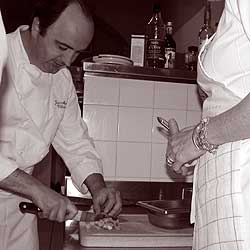 M. Villard: I was 16 or 17 years old. The restaurant prepared traditional food, but good food. Traditional French recipes with good sauces that take a long time to make — fresh fish — fresh vegetables — we had a lot of fresh food. So I completed my apprenticeship and went to another restaurant, l’Oasis in La Napoule. L’Oasis was a three-star [restaurant] in the Michelin guide. It was a big change for me because there were about 15 to 18 cooks in the kitchen. There were different stations. I worked in the entrée station and also the vegetable station. It was a good, but difficult experience. It was not convivial like the small restaurant [where I apprenticed]. With so many cooks there was a lot of competition. It’s always like that in a three-star restaurant. After that, I did my military service. I was in the French navy for a year — in the Indian Ocean — as a cook. It was a good experience. I did many buffets for the staff on the boat. My parents were in Dijon, so when I got out of the navy I worked in a good restaurant in Dijon for about a year. Then I came back to Lyon. In Lyon, I worked in a restaurant called Le Gourmandin — it doesn’t exist any more — it was also a good restaurant. Following that I went to the United States. I stayed one year in St. Louis, Missouri, in a French restaurant. I was the chef. It was a good experience, but difficult.
M. Villard: I was 16 or 17 years old. The restaurant prepared traditional food, but good food. Traditional French recipes with good sauces that take a long time to make — fresh fish — fresh vegetables — we had a lot of fresh food. So I completed my apprenticeship and went to another restaurant, l’Oasis in La Napoule. L’Oasis was a three-star [restaurant] in the Michelin guide. It was a big change for me because there were about 15 to 18 cooks in the kitchen. There were different stations. I worked in the entrée station and also the vegetable station. It was a good, but difficult experience. It was not convivial like the small restaurant [where I apprenticed]. With so many cooks there was a lot of competition. It’s always like that in a three-star restaurant. After that, I did my military service. I was in the French navy for a year — in the Indian Ocean — as a cook. It was a good experience. I did many buffets for the staff on the boat. My parents were in Dijon, so when I got out of the navy I worked in a good restaurant in Dijon for about a year. Then I came back to Lyon. In Lyon, I worked in a restaurant called Le Gourmandin — it doesn’t exist any more — it was also a good restaurant. Following that I went to the United States. I stayed one year in St. Louis, Missouri, in a French restaurant. I was the chef. It was a good experience, but difficult.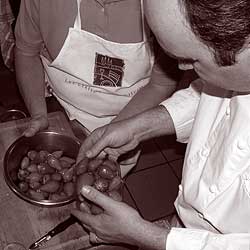 M. Villard: This was the 1980s. The customer’s expectations were different from what I was used to. And the waiters were a problem. The waiters all had other jobs. They were not professional waiters, like in France. In France you have to learn how to be a waiter or a maître d’ or a chef. One day they’d come to work, and the next they wouldn’t. It was very difficult to work in those conditions. After that I came back to Lyon and worked for a few months in a restaurant. But, by then I had two children and I wanted to work someplace where I could be home at night. I got a job as a manager for Sodexo, which served meals for companies and schools.
M. Villard: This was the 1980s. The customer’s expectations were different from what I was used to. And the waiters were a problem. The waiters all had other jobs. They were not professional waiters, like in France. In France you have to learn how to be a waiter or a maître d’ or a chef. One day they’d come to work, and the next they wouldn’t. It was very difficult to work in those conditions. After that I came back to Lyon and worked for a few months in a restaurant. But, by then I had two children and I wanted to work someplace where I could be home at night. I got a job as a manager for Sodexo, which served meals for companies and schools.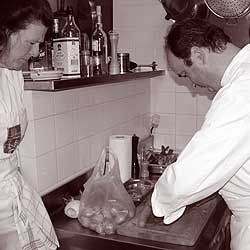 M. Villard: My part was all hands-on. There was demonstration and hands-on classes in the school. The students had classes in theory and practical experience. I decided with the owner of the school that I wanted to just be a teacher and not work as a chef at the same time. So I left the restaurant and joined the department that taught cooking classes for amateurs. We put together a four-month long program for amateurs from all over the world. I love to create new programs and to teach students from different countries.
M. Villard: My part was all hands-on. There was demonstration and hands-on classes in the school. The students had classes in theory and practical experience. I decided with the owner of the school that I wanted to just be a teacher and not work as a chef at the same time. So I left the restaurant and joined the department that taught cooking classes for amateurs. We put together a four-month long program for amateurs from all over the world. I love to create new programs and to teach students from different countries.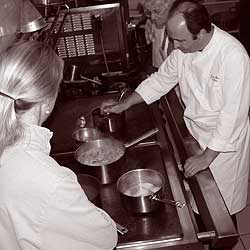 M. Villard: No. I was at the school for a total of about eleven years, but I’m no longer associated with them. They sometimes ask me to do a cooking class for students. I’m still on good terms with them, but I’m no longer an employee.
M. Villard: No. I was at the school for a total of about eleven years, but I’m no longer associated with them. They sometimes ask me to do a cooking class for students. I’m still on good terms with them, but I’m no longer an employee.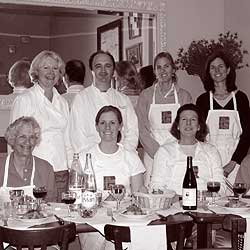 M. Villard: Yes. Demonstrations are okay, but hands-on is more convivial, and that’s much better for the student. If you want to learn to cook you have to get your hands dirty, you have to practice.
M. Villard: Yes. Demonstrations are okay, but hands-on is more convivial, and that’s much better for the student. If you want to learn to cook you have to get your hands dirty, you have to practice.
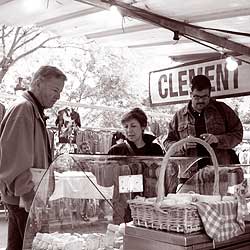 Mme. Caillat: Yes, I took formal classes for a whole year five years ago. La ville de Paris, the city of Paris, offers professional classes and I took patisserie from a man who was a traditional, older chef. Patisserie also included a little bit of cooking. I’ve never used any of the recipes we did in the class – never — because it’s exactly the style I don’t like. When I changed my career, I could have applied through the French government and gone back to cooking school, but I was not interested in learning lapin chasseur and all the other classics. I have the books, I know how to do these dishes properly, they’re not the kind of recipes I’m interested in. I learned a lot of thing in that class, but not the recipes — all the other little details around the recipes, the little tricks.
Mme. Caillat: Yes, I took formal classes for a whole year five years ago. La ville de Paris, the city of Paris, offers professional classes and I took patisserie from a man who was a traditional, older chef. Patisserie also included a little bit of cooking. I’ve never used any of the recipes we did in the class – never — because it’s exactly the style I don’t like. When I changed my career, I could have applied through the French government and gone back to cooking school, but I was not interested in learning lapin chasseur and all the other classics. I have the books, I know how to do these dishes properly, they’re not the kind of recipes I’m interested in. I learned a lot of thing in that class, but not the recipes — all the other little details around the recipes, the little tricks.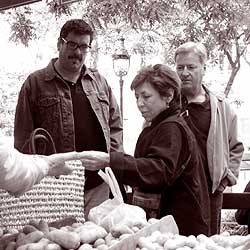 Mme. Caillat: No. I have people who are very interested in baking, but they want to know how to make a tarte, and I have a secret crust that is against every rule of baking. It came from my grandmother and her sister. This is a revolutionary method for making a wonderful crust that I learned from them. It’s made in five minutes and you can’t fail. So I make a tarte and students are very happy.
Mme. Caillat: No. I have people who are very interested in baking, but they want to know how to make a tarte, and I have a secret crust that is against every rule of baking. It came from my grandmother and her sister. This is a revolutionary method for making a wonderful crust that I learned from them. It’s made in five minutes and you can’t fail. So I make a tarte and students are very happy.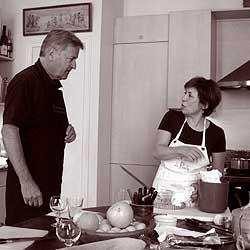 Mme. Caillat: Marymount ended because they tore down kitchen. They needed space for more classrooms. I knew I wanted to keep teaching expats. So I moved here. I built this large kitchen. I wasn’t sure what I was going to do, but I knew I wanted to continue to teach cooking. By pure coincidence because I never thought there was a market for tourists — it didn’t cross my mind — but someone connected me with a culinary web site. Shortly thereafter I started getting tourists. To my great surprise, there was a market [for] teaching visitors. What is different with a visitor, is that my goal is to teach something that they can recreate in their home. So when I go to America, I spend my time in the markets checking which products are available. Remember, I am not a chef. I claim to be a cuisinière [a cook] — meaning I do things that are accessible — that can be recreated. I try to do the best food I can with the best products I can obtain. The idea is to give people happiness — to give them something they will remember. I know I succeed because I get emails where people say they cherish their memory and they’ve recreated their French meal [in their home]. And many return for more classes — not everyone, but most. It takes a lot of planning. I establish the menu in advance with the student. I don’t ask them which dish, but I give them a choice. “Do you want meat, do you want poultry, or do you want fish?” If they want meat, I practically never do beef because steaks are not interesting and the other beef recipes take hours to prepare. But people don’t ask for beef because Americans are so good with beef already. There are trends. For two years the trend was fish and poultry — nothing but fish and poultry — poultry meaning chicken, of course, the most boring thing I can think of. But sometimes I did guinea hen. Then pork became trendy, but now it’s lamb and veal. Most of the time I’ll do a soufflé as a first course because it involves technique, but still it’s simple — and it’s so French. I do a cheese soufflé in the winter. [In the summer] I do an asparagus soufflé or a mushroom soufflé or whatever. They are very happy. They are not intimidated anymore by the soufflé. For dessert it’s usually a tarte. So I ask, “Would you like chocolate or fruit?” Sometimes I do both if the class is large, but I nevery take more than six people in a class. The classes always start with going to the market — which is essential. I always need to pick up fresh vegetables or herbs or something — plus I love it. People come here and I can take them to my market. I don’t have this façade that everything is beautiful. On the contrary, I think most of it’s merde! I go to one or two producers and we discuss what’s available. If I need fish, there’s an excellent fish stand at the market. I pick up my herbs. I show the students a stand where there are all the olives in the world. We pick up some cheese. We buy a very good baguette at the only good bakery in the neighborhood. I always pick up something special to add to the menu. I just love it (and the students love it with me). It’s always quite an experience. We get back here at about 10:30 and we cook — and I could not imagine anything but hands-on. I direct things very well. I detect who will do what. There’s always a little chopping or peeling. Each student has his recipes. Everyone is different. Then we sit down and we eat and converse for about an hour.
Mme. Caillat: Marymount ended because they tore down kitchen. They needed space for more classrooms. I knew I wanted to keep teaching expats. So I moved here. I built this large kitchen. I wasn’t sure what I was going to do, but I knew I wanted to continue to teach cooking. By pure coincidence because I never thought there was a market for tourists — it didn’t cross my mind — but someone connected me with a culinary web site. Shortly thereafter I started getting tourists. To my great surprise, there was a market [for] teaching visitors. What is different with a visitor, is that my goal is to teach something that they can recreate in their home. So when I go to America, I spend my time in the markets checking which products are available. Remember, I am not a chef. I claim to be a cuisinière [a cook] — meaning I do things that are accessible — that can be recreated. I try to do the best food I can with the best products I can obtain. The idea is to give people happiness — to give them something they will remember. I know I succeed because I get emails where people say they cherish their memory and they’ve recreated their French meal [in their home]. And many return for more classes — not everyone, but most. It takes a lot of planning. I establish the menu in advance with the student. I don’t ask them which dish, but I give them a choice. “Do you want meat, do you want poultry, or do you want fish?” If they want meat, I practically never do beef because steaks are not interesting and the other beef recipes take hours to prepare. But people don’t ask for beef because Americans are so good with beef already. There are trends. For two years the trend was fish and poultry — nothing but fish and poultry — poultry meaning chicken, of course, the most boring thing I can think of. But sometimes I did guinea hen. Then pork became trendy, but now it’s lamb and veal. Most of the time I’ll do a soufflé as a first course because it involves technique, but still it’s simple — and it’s so French. I do a cheese soufflé in the winter. [In the summer] I do an asparagus soufflé or a mushroom soufflé or whatever. They are very happy. They are not intimidated anymore by the soufflé. For dessert it’s usually a tarte. So I ask, “Would you like chocolate or fruit?” Sometimes I do both if the class is large, but I nevery take more than six people in a class. The classes always start with going to the market — which is essential. I always need to pick up fresh vegetables or herbs or something — plus I love it. People come here and I can take them to my market. I don’t have this façade that everything is beautiful. On the contrary, I think most of it’s merde! I go to one or two producers and we discuss what’s available. If I need fish, there’s an excellent fish stand at the market. I pick up my herbs. I show the students a stand where there are all the olives in the world. We pick up some cheese. We buy a very good baguette at the only good bakery in the neighborhood. I always pick up something special to add to the menu. I just love it (and the students love it with me). It’s always quite an experience. We get back here at about 10:30 and we cook — and I could not imagine anything but hands-on. I direct things very well. I detect who will do what. There’s always a little chopping or peeling. Each student has his recipes. Everyone is different. Then we sit down and we eat and converse for about an hour.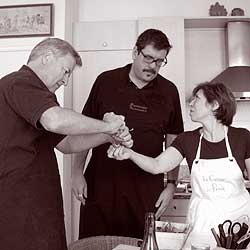 Mme. Caillat: Of course, but I do encourage them to participate. This year there are less students than previously — there’s less Americans coming to Paris — but now every person who comes is super motivated. It wasn’t that way before when I was busier. I haven’t had anyone just watching in a long time.
Mme. Caillat: Of course, but I do encourage them to participate. This year there are less students than previously — there’s less Americans coming to Paris — but now every person who comes is super motivated. It wasn’t that way before when I was busier. I haven’t had anyone just watching in a long time.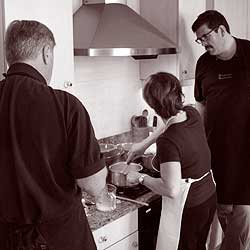 Mme. Caillat: Yes, there’s the promenade gourmande in the afternoons after the market tour and cooking. I don’t remember how I developed that. I love that part, too. We go to my spice shop — it’s very special. And we go to Dehillerin. We go to Stohrer — it’s the oldest pastry shop in Paris and it’s beautiful. Then I take them to my favorite wine shop where we can sit and have a wine tasting. Then we go to the Poilâne bakery — which everyone says is the highlight — we even go to the old oven down in the basement. And I can take them to other places if they ask me, but they have to ask in advance because we can’t just drop in on people.
Mme. Caillat: Yes, there’s the promenade gourmande in the afternoons after the market tour and cooking. I don’t remember how I developed that. I love that part, too. We go to my spice shop — it’s very special. And we go to Dehillerin. We go to Stohrer — it’s the oldest pastry shop in Paris and it’s beautiful. Then I take them to my favorite wine shop where we can sit and have a wine tasting. Then we go to the Poilâne bakery — which everyone says is the highlight — we even go to the old oven down in the basement. And I can take them to other places if they ask me, but they have to ask in advance because we can’t just drop in on people.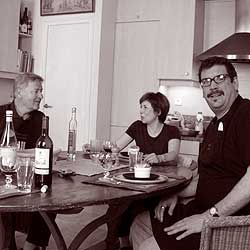 Mme. Caillat: Yes, but they are not very clear yet. I have a friend who is a catador. She studied olive oil in Spain at the university. She has a degree from the university — she’s like a enologist of olive oil. What is happening more and more here is that people are beginning to understand that, like wine, coffee, chocolate, and tea, olive oil is a result of the variety of fruit that is used [in its creation]. There are many varieties of olive oil. And Françoise conducts tastings where people differentiate the different taste of different oils. To learn what is a fault and what isn’t — bitterness is not a fault. They learn to detect a real fault when there is one. So my idea is, with her, to go to America and to do classes around the subject of olive oil. That’s one of my plans. I’d like to do more trips around France. Maybe one day I’ll write a book. I’m interested in the slow food movement. I’d like to teach courses about the science of food or the history of food in France. My goal is not to have a restaurant. And I can’t really see myself writing a recipe book. I think there are so many wonderful books already.
Mme. Caillat: Yes, but they are not very clear yet. I have a friend who is a catador. She studied olive oil in Spain at the university. She has a degree from the university — she’s like a enologist of olive oil. What is happening more and more here is that people are beginning to understand that, like wine, coffee, chocolate, and tea, olive oil is a result of the variety of fruit that is used [in its creation]. There are many varieties of olive oil. And Françoise conducts tastings where people differentiate the different taste of different oils. To learn what is a fault and what isn’t — bitterness is not a fault. They learn to detect a real fault when there is one. So my idea is, with her, to go to America and to do classes around the subject of olive oil. That’s one of my plans. I’d like to do more trips around France. Maybe one day I’ll write a book. I’m interested in the slow food movement. I’d like to teach courses about the science of food or the history of food in France. My goal is not to have a restaurant. And I can’t really see myself writing a recipe book. I think there are so many wonderful books already.